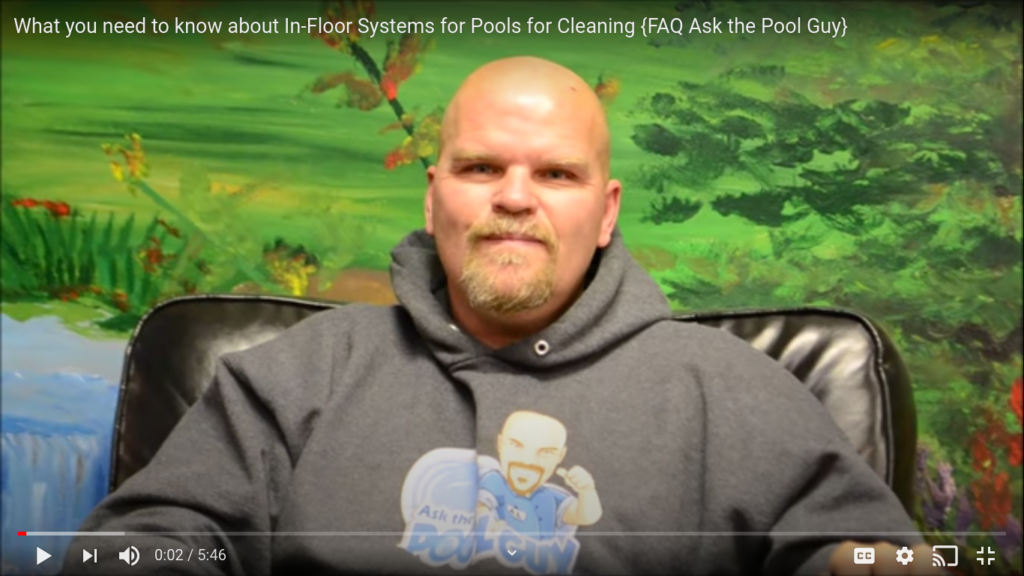
Something that we’ve adopted using in the last several years, that’s not popular in our area, where we’re at, is the in-floor systems. Now, I know that they were originally designed to be in-floor cleaning systems simply to sweep and clean the pool. What I’ve found though, being that we’ve adopted them to the north … The big key was to make sure that we were able to winterize and close them properly so we don’t have any problems with the plumbing. What I’ve found is it’s an efficiency system, and that’s how I sell it today. Is it’s efficient. You’re heating the pool from the bottom up. It only makes sense. If for no other reason than to heat the pool from the bottom up, that’s the reason to do it. You add the chemicals at the bottom; way more efficient. Anything that is added to the top, evaporation, sunlight, the sun, quick loss. Add it at the bottom, you get a nice slow rise in the temperature from the bottom up, you get a nice thermal … Don’t have these thermal layers of warm and cold. You have nice even pool temperature. The chemical disbursement is much better because especially as you’re heating the water, the water is tending to rise and it is drawing the chemicals with it. So you’re sanitized from top to bottom, really love that efficiency part of it. The other part is the cleaning, what they’re sold as, in-floor cleaning systems. As each head pops up in each zone, it’s kind of like a sprinkler system, the zone pops up, the head turns and goes back down. The next one it pops up it turns and it sweeps the pool clean, and it’s typically going to do 80 to 90% of the pool. There is always that little area that needs some hand cleaning. I don’t know that anything has been designed yet to 100% clean a pool, although they are pretty good. It depends on how robust the system is and how much money you want to spend in bulking up the size of the system. They are pretty good at keeping the pool clean. There are a few spots that you’re going to have to touch up on your own, but gone are the days, if you have one, that you have to sit out there and vacuum the pool all the time. You don’t have to because it’s basically operating and sweeping itself.
The other huge advantage today is using a variable speed pump. Instead of your pump running for eight hours a day and shutting off, now we can run twenty-four hours a day at a lower rpm, keep that water moving at all times and sweeping and cleaning continually, all day and all night, and that is another part of that efficiency that’s made in-floor that much more important. In-floor cleaning systems are all mechanical. They’re not electrical. You have an electric pump that driving water through a mechanical system.
Some of those valves are really simple; that have simply a turbine that turns a set of gears that that mechanical valve just slowly turns from zone to zone. Others are a little bit more involved, a little more intricate with a lot of little parts that shift. It goes from here and it shifts hard to the next zone, shifts hard to the next zone. The advantage of that is it’s stop, start, stop, start, stop, start. The difficulty with that is the flow through the system, because as soon as you stop and shift zones you back the system up and the pressure goes up, and the pressure goes down, and the pressure goes up.
There’s no right answer, there’s no wrong answer in terms of which one’s better. Each of the manufacturers will claim why theirs is the best on the market. I think they probably all have certain advantages and certain disadvantages, but the systems are all the same, six port valve with a feed back from the pump and then six ports out to the pool. I know that one of the manufacturers I think has a nine now, but that one is not very popular. It’s not used nearly as much. Although, we’ve built a few systems that had two six ports. We had twelve separate zones in the pool, because of a lot of the detailed stuff you want to have as many zones as possible. Sometimes six just isn’t enough. For a general pool, that’s what it is. Realize, it’s not electrical, it’s mechanical. It’s water moving through that valve. It’s moving parts inside that valve which is getting the mechanical things to happen and the water to shift.SHOW LESS
